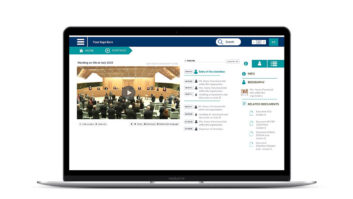Guiding your employees
Oct 1, 1998 12:00 PM,
Milton Zall
There is a generally held belief that an enlightened business should havean employee handbook. An employee handbook can effectively communicate yourcompany’s goals, expectations and commitments to your employees. Ifconstructed properly, an employee handbook can be an extremely valuabletool in managing your human resources.
Some argue, however, that a handbook is costly and not worth the effort.Others believe that a handbook reduces management’s flexibility to manageits workforce, and it exposes your company to claims and additionalexpenses. These are, admittedly, valid points. Further, when composing anemployee handbook, care must be taken not to state anything that couldcreate problems for your company later. For that reason, the handbookshould be reviewed by the company attorney before distribution to youremployees.
There are a number of advantages inherent in having an employee handbook.It provides your company with an excellent vehicle for communicating yourcompany’s goals, history, structure and policies to your employees.
Moreover, a handbook can help establish common employee guidelines andrules of conduct. Your handbook can communicate an at-will employmentpolicy, thereby minimizing the risk of successful unlawful terminationsuits. If there is a conspicuous disclaimer of anything other thanemployment at-will in your handbook, and this disclaimer is emphasized andclearly indicates that the employee handbook is not intended to create abinding obligation, you can probably avoid a finding that a contract wasentered into.
The odds in your favor increase if the employee signs an appropriatelyworded disclaimer at the time of hire in which it clearly disclaims theintent to enter a contract limiting the right to discharge employees.Careful analysis must accompany your distribution of policy proceduressubsequent to the issuance of an employment handbook, and care must beexercised by supervisory personnel in making promises or giving assurancesto employees about procedures not clearly delineated in the handbook. Aproperly drafted employment handbook may often discourage the filing ofemployee claims, or if filed, may result in a pre-trial disposition withoutthe expense of trial. Your handbook also enables you to articulate yourcompany’s position on discrimination, sexual harassment and similaremployee claims, providing a solid defense against such claims.
An employee handbook, however, should not be viewed solely as a device toprotect your company from litigation; it should additionally providesummary information to employees about personnel policies, benefits andcompensation plans. Studies have shown that well-informed employees aremore productive than those kept in the dark. In the unfortunate cases wheredisputes arise, your employee handbook is the means of resolution.
At times, a company debates whether to develop its own handbook or buy anoff-the-shelf product. Such products are often unnecessarily complicatedand contain too much legal jargon, thereby preventing it from being asaccessible as it needs to be to serve its function adequately. In addition,a published handbook may not represent the legal nuances of your state thataffect the employment relationships. An absolute essentiality for creatinga handbook is tailoring it to the employees to whom it will apply; cannedhandbooks are rarely appropriate.
The principal risk accompanying a decision to develop your own handbook isthat the handbook could create actual or implied contractual commitmentsfrom the company to the employee. To minimize this risk, your employeehandbook must specifically state that both its provisions are notcommitments and the company can change its provisions at any time withoutnotice or discussion.
Before embarking on an employee handbook project, it is important torecognize that a handbook might limit flexibility in managing theworkforce. If the handbook includes language allowing the employer to makechanges mentioned above, these limitations should not be a problem. Thehandbook’s limitations will be welcome as long as it requires the companyto adhere to applicable laws and treat employees consistently. With thereasons for creating an employee handbook established, let’s examine thehandbook itself. It should contain an introduction, corporate history,goals, values and beliefs and disclaimers.
The introductionThe introduction is an important component of your company’s employeehandbook. In this section, you welcome new employees to the company andoffer a brief description of the company, its mission, values and beliefs.The introduction may also be an appropriate place to present some of thecompany’s long-term goals, but do not recreate the business plan in thehandbook. It should provide a few essential statements so that newemployees have the opportunity to learn about the company from thebeginning. The handbook should include the corporate mission statement anddescribe the employee’s role in fulfilling this mission in general terms.
Many companies structure the introduction section into the form of awelcome letter to employees, as shown in the example below:
Dear Employee,
Welcome to ABC Corporation. We are excited to have you as part of our team.You were hired because we believe you can contribute both to theachievement of our goals and to the bottom line of success, and you shareour commitment to our mission statement.
ABC is committed to distinctive quality and unparalleled customer servicein all aspects of our business. As part of the ABC team, you will discoverthat the pursuit of excellence is truly a rewarding aspect of your careerwith ABC.
This employee handbook contains the essential policies, goals, benefits andexpectations of ABC Corporation and other information you will find helpfulin carrying out your responsibilities.
Our mission statement:At ABC, we pledge to provide distinctive quality and unparalleled customerservice as we strive to gain the respect and trust of our customers,suppliers and partner vendors.
The success of ABC is dependent upon our operation as a unified team. Wehave to earn the trust and respect of our customers every day so that thecustomer will continue to choose our company over our competitors. We offerservice, and service is provided by people. There are no magic formulas.
Our success is guaranteed by creative, productive employees who areempowered to make suggestions that will enable the company to provide thebest possible service. Your job, every job, is essential to fulfilling ourmission to “provide distinctive quality and unparalleled customer service”every day to more people who “trust and respect” us. The primary goal atABC, and yours, is to fulfill our mission statement and continue as anindustry leader, which is attainable only through dedicated hard work andcommitment from every employee. It is the desire of ABC’s management, fromtop to bottom, to have every employee succeed in his or her job and assistin achieving our goals.
You should use this handbook as a ready reference as you pursue your careerwith ABC. Additionally, the handbook should assure good management and fairtreatment of all employees. At ABC, we strive to recognize thecontributions of all employees. Welcome aboard, and we look forward to yourcontribution.
The remainder of the introduction should contain a statement of thecompany’s values and beliefs, its goals, an overview of the company and theequal opportunity employment affirmation. Because this is your employeehandbook, make sure the content relates to the employee and is presented inan accessible, not intimidating, tone and style.
Corporate historyThis is the place to detail the background and accomplishments of thecompany and its status (size, locations, customer base and departments). Besure to keep it brief and inspirational. It is always a good idea to fostera sense of history.
Goals, values and beliefsIn this section, state what you expect of your employees and what youremployees can expect of you. You should also spell out the company’sgeneral philosophies. Some of the topics that should be covered in thissection are: attendance, absenteeism and leave of absence; employeebenefits administration; seniority, promotions, transfers and redundancyprocedures; conduct, discipline and termination; complaint and grievanceprocedures; employment expenses and reimbursement; health, safety andsecurity; customer service and quality standards; employee responsibilitiesand business ethics; disclaimers. Here is an example:
Our goal at ABC is simple-extraordinary customer service as we provide ourcustomer’s needs in the personal service industry. We accomplish this byassuming the tasks that interfere with an enjoyable, leisurely lifestyle,and by collaborating with organizations who have the finest reputations forquality. Our goals are accomplished by a commitment from every employee.Our values and beliefs require that we treat each employee with respect andgive him or her an opportunity for input on how to continually improve ourservice goals. The company does not tolerate discrimination of any kind andencourages all managers and supervisors to involve employees in problemsolving and the creative process. When problems arise, the facts should beanalyzed to determine ways to avoid similar problems in the future. Providethe most effective and efficient corrective action to resolve customerservice issues and ensure both our customers’ satisfaction and theprevention of that problem’s recurrence. In this way, we will maintain ourleadership position in the industry. Foster an open-door policy thatencourages interaction, discussion and ideas to improve the workenvironment, thus increasing productivity. Deliver competitive, impeccableservice to our customers and, where required, collaborate our customerswith vendors who share our mission vision. Make “Do It Right the FirstTime” our commitment as a team and our only way of doing business. Thiscommitment will ensure continued growth and prosperity.
This is an example only, but it gives you the idea. Your goals can includemore specific long-term goals, but if you do, make sure they are not sospecific that they become dated after one or two years.
Be circumspect as to what you promise your employees in your company’semployee handbook. The 2nd District United States Circuit Court of Appealsrecently upheld a 1997 jury award of $377,077 in back pay to AntonioMarfia. Marfia was fired by his employer after he rejected a competitor’sjob offer. Marfia’s employer had assured him of continued employment, andthen fired him. Marfia successfully established a claim of “breach ofimplied contract” based on what was in the company’s employee handbook aswell as the oral guarantee Marfia received from his boss.
In his ruling, Judge Jose Cabranes said that Marfia had presumed that hisjob was safe because of his reliance upon a written policy in the employeehandbook. Marfia also relied upon the oral statements made by his boss whenhe turned down the competitor’s offer. The presence of these two conditionswas sufficient to rebut New York’s presumption that an employmentrelationship is at will and can be terminated at any time.
In rejecting the employer’s arguments that it had no formal written policygoverning terminations, the court ruled that such a policy was establishedby a statement in the company’s employee handbook that said employees wouldbe disciplined “only for just and good cause.” Although the employer arguedthat the discipline provision did not cover termination, the judge rejectedthis argument. A number of other states (including CA, CT, IL, IA, MS, MAand NJ) will give contract status to an employee handbook act in fittingcircumstances. New York has traditionally been more reluctant to find suchcontracts, although federal courts have usually been more receptive to theargument that a company handbook has contract status.
DisclaimersWhen employers provide an employee handbook with a disclaimer stating thatthe handbook does not constitute a contract, the employer cannot enforce anarbitration clause if one is contained in the handbook, thereby forcing anemployee to arbitrate any disputes. For years, employers have includedprovisions stating that the handbook did not constitute a contract betweenthe employer and the employee. In suits brought by employees for breach ofcontract, courts once enforced these disclaimer provisions in favor of theemployer.
A recent Michigan Supreme Court case, however, involved an employer who wassued by one of its employees for alleged discrimination. The employerargued that because the employee handbook contained an arbitration clauserequiring all disputes to be resolved through arbitration, the employee’slawsuit could not go forward. The court, in ruling in favor of theemployee, pointed out that because the handbook also contained the typicaldisclaimer that the handbook was not intended to constitute a contract, thearbitration clause contained in the handbook could not be enforced.
This decision cuts both ways. Employers have been put on notice that theyare not free to enforce the disclaimer provisions contained in theirhandbooks selectively. Employers who use the disclaimer provision containedin their handbook to shield themselves against breach of contract actionsof their employees cannot cite the same handbook when seeking to enforcesuch provisions as arbitration clauses contained in the handbook, which arebeneficial to the employer. Here is an example of a well-crafted disclaimer:
Employment at-willAlthough the company maintains a belief in the policies and proceduresdescribed here, they are not, however, conditions of employment and are notintended to form any contract between the company and its employees. Youremployment is an employment-at-will relationship, meaning that both you andthis company may terminate employment at any time with or without notice,with or without cause.
ConclusionAlthough the employee handbook is meant to serve as a means of readilyconveying corporate policy and philosophy to employees, it can sometimescreate more difficulties than it circumvents. Clean, precise wordingprevents the reader’s alienation from the handbook’s meaning, andunnecessarily confusing your employees not only serves contrary to thehand-book’s design, but it can also engender legal difficulties. Follow theinstructions above, and you will be well on your way to ensuring that youremployees are fully aware of corporate policy.










